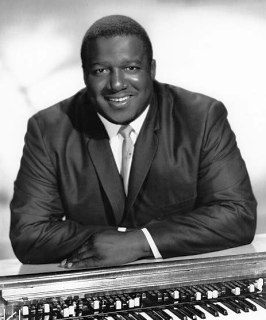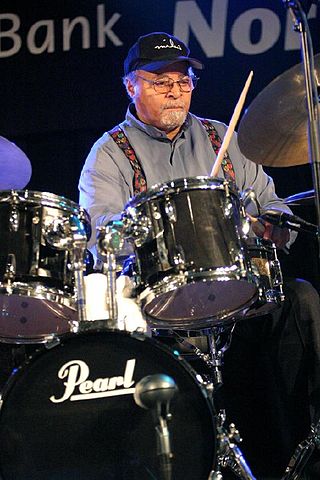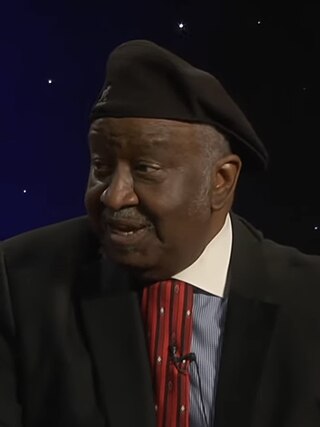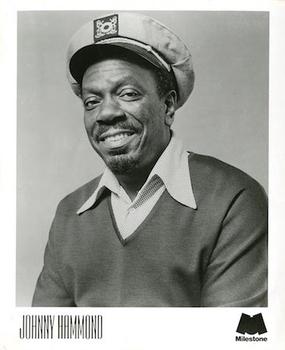Related Research Articles

Joseph Rudolph "Philly Joe" Jones was an American jazz drummer.

Richard Arnold "Groove" Holmes was an American jazz organist who performed in the hard bop and soul jazz genre. He is best known for his 1965 recording of "Misty".

Houston Person is an American jazz tenor saxophonist and record producer. Although he has performed in the hard bop and swing genres, he is most experienced in and best known for his work in soul jazz. He received the "Eubie Blake Jazz Award" in 1982.

Melbourne Robert Cranshaw was an American jazz bassist. His career spanned the heyday of Blue Note Records to his later involvement with the Musicians Union. He is perhaps best known for his long association with Sonny Rollins. Cranshaw performed in Rollins's working band on and off for over five decades, starting with a live appearance at the 1959 Playboy jazz festival in Chicago and on record with the 1962 album The Bridge.

Albert "Tootie" Heath was an American jazz hard bop drummer, the brother of tenor saxophonist Jimmy Heath and the double-bassist Percy Heath. With Stanley Cowell, the Heaths formed the Heath Brothers jazz band in 1975.

Wilbur James "Jimmy" Cobb was an American jazz drummer. He was part of Miles Davis's First Great Sextet. At the time of his death, he had been the Sextet's last surviving member for nearly thirty years. He was awarded an NEA Jazz Masters Fellowship in 2009.

George Edward Coleman is an American jazz saxophonist known for his work with Miles Davis and Herbie Hancock in the 1960s. In 2015, he was named an NEA Jazz Master.

Clifford Laconia Jordan was an American jazz tenor saxophone player and composer. Originally from Chicago, Jordan later moved to New York City, where he recorded extensively in addition to touring across both Europe and Africa. He recorded and performed with Art Farmer, Horace Silver, Max Roach, J.J. Johnson, and Kenny Dorham, among others. In later years, performed with Cedar Walton's quartet Eastern Rebellion, and led his own groups, including a big band.

Bernard Lee "Pretty" Purdie is an American drummer, and an influential R&B, soul and funk musician. He is known for his precise musical time-keeping and his signature use of triplets against a half-time backbeat: the "Purdie Shuffle." He was inducted into the Modern Drummer Hall of Fame in 2013.

John Robert "Johnny Hammond" Smith was an American soul jazz and hard bop organist. Born in Louisville, Kentucky, he was a renowned player of the Hammond B-3 organ so earning "Hammond" as a nickname, which also avoided his being confused with jazz guitarist Johnny Smith though this could lead to him being confused with Jimmy Smith (musician), another Hammond great.

Samuel Jones was an American jazz double bassist, cellist, and composer.

James Harrell McGriff was an American hard bop and soul-jazz organist and organ trio bandleader.
Melvin Sparks was an American soul jazz, hard bop and jazz blues guitarist. He recorded a number of albums for Prestige Records, later recording for Savant Records. He appeared on several recordings with musicians including Lou Donaldson, Sonny Stitt, Leon Spencer and Johnny Hammond Smith.
Roy McCurdy is a jazz drummer.
Lawrence Bernard Gales was an American jazz double-bassist.
Don Patterson was an American jazz organist.

Happy Ground is the second album by American jazz vibraphonist Johnny Lytle which was recorded in 1961 for the Jazzland label. The album was later reissued on the Riverside label in 1963.

Nice and Easy is the third album led by American jazz vibraphonist Johnny Lytle which was recorded in 1962 for the Jazzland label.

Good Vibes is an album by American jazz vibraphonist Johnny Lytle which was recorded in 1981 for the Muse label.

Benjamin Alexander Riley Jr. was an American jazz drummer known for his work with Thelonious Monk, as well as Alice Coltrane, Stan Getz, Eddie "Lockjaw" Davis, Ahmad Jamal, and as a member of the group Sphere. During the 1970s and 1980s he was a member of the New York Jazz Quartet.
References
- ↑ Andrew Jaffe, revised by Barry Kernfeld (2003). "Lytle, Johnny [John Dillard ]". Grove Music Online (8th ed.). Oxford University Press. doi:10.1093/gmo/9781561592630.article.J277600. ISBN 978-1-56159-263-0.
- ↑ "Johnny Lyle".(registration required)